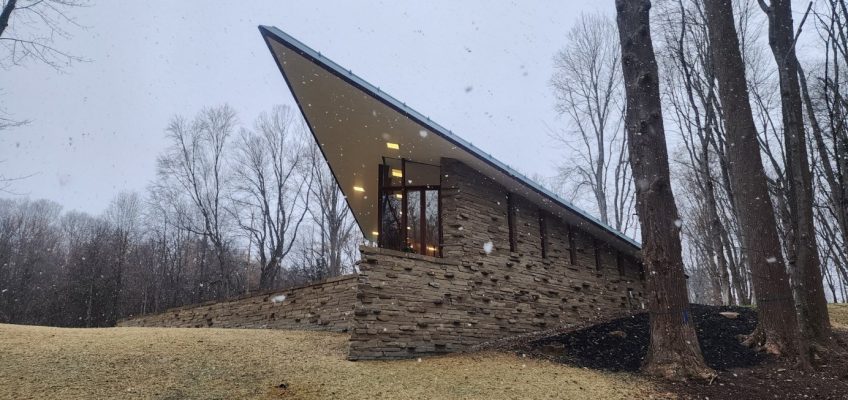The construction of Frank Lloyd Wright’s last project, “RiverRock,” has reached completion and is now open for overnight rentals in Willoughby Hills.
While internationally renowned for his flagship projects including Fallingwater in Pennsylvania, the Johnson Wax Company headquarters in Wisconsin, The Ennis House in Los Angeles and the Guggenheim Museum in New York, Wright also created a design for smaller, more affordable residences called Usonian homes.
“RiverRock” was Wright’s final Usonian home blueprint, delivered in 1959. More than 60 years later, the three-bedroom, two-bathroom home was built on the homesite as originally intended, following Wright’s original plans while also meeting modern building code regulations.
The property, located at 2217 River Road, was purchased by Sarah Dykstra in 2018. The purchase included an existing 1955 Wright home called The Louis Penfield House, as well as the unbuilt Wright plan known as Project #5909 in the Taliesin Archives, Wright’s office.
The plans for what would eventually become RiverRock were created for the Penfield family as their existing Wright home was slated for demolition to make way for an interstate highway. The highway planning commission was able to move the road, ultimately saving the Penfield residence.
In late 2022, Sarah and her mother, Debbie Dykstra, set out to build this last piece of history, Wright’s final Usonian home plan #5909. Serving as general contractors, the Dykstras reviewed the plans with a handpicked team of architects and engineers who are also Wright enthusiasts.
The quest was to build Wright’s final design true to his plan, its intent and spirit while also ensuring that the home would meet current building regulations.
“When we set out to build this home, we gave a mandate to the professional team involved: if you must change something due to current building regulations, code, products, etc., do so under the ‘skin’ so the house will look exactly the same,” said Sarah, owner and co-general contractor of RiverRock. “The design and the artistic aspect of this home should remain the same as intended in 1959. We are thrilled our team of construction professionals delivered on this promise and are proud to present a beautiful 2025 build from Wright’s 1959 plans.”
A hallmark of Wright plans feature placing the home or office building within its natural setting, using local materials to blend into the landscape. The plans for RiverRock required a large quantity of local stone to be used in the design, Sarah said.
Penfield, original owner of the plans, built a small, stone structure in the 1960s to be used as his art studio. Near this structure, piles of additional stone were found by the Dykstras.
Additionally, through the discovery of old photos and discussions with Paul Penfield, Louis’s son, the Dykstras learned this stone was harvested from the Chagrin River in the 1960s by Louis. With the intention of building #5909 from this harvested stone, Louis dubbed the house RiverRock.
The Dykstras incorporated the same stone into the construction of the home. To emphasize the importance of this discovered rock, Sarah kept the RiverRock name.
Wright’s original plans for the home — supplemental structural engineering drawings — were submitted for review and permitting to the Willoughby Hills Building Department and Architectural Review Board, as well as the Lake County Building Department. Those plans were approved in June of 2023. Groundbreaking and construction commenced that October.
Construction was completed last month.
The home is approximately 2,000 square feet and features heated floors, three bedrooms, two queen bedrooms and one bedroom with two extra large twin beds, one full bathroom, one bathroom with shower, full kitchen, a large glass-walled living room with expansive views of the property and a wood-burning fireplace.
The unbuilt project from history came with a unique set of considerations and complications as the architect and his core team are long deceased, Sarah said. Key questions the construction team faced included what would Wright do, who can make interpretations from the original architect, what modifications must be made to meet modern building codes and how are those incorporated while preserving the master design.
Another question raised was how will the new construction impact the legacy of the original architect.
“Wright did more than design structures,” said Debbie, the co-general contractor. “He created living works of art and dotted them into nature. We feel Wright’s legacy has been both honored and broadened by the construction team. Our intention, by opening the home for overnight stays, is to allow guests to decide for themselves. We hope they see and feel what we do from RiverRock.”


Leave a Reply